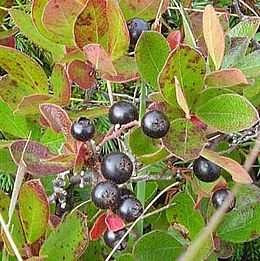Huckleberry


Huckleberry is a name used in North America for several plants in the family Ericaceae, in two closely related genera: Vaccinium and Gaylussacia. The huckleberry is the state fruit of Idaho.
Nomenclature
The name 'huckleberry' is a North American variation of the English dialectal name variously 'hurtleberry' or 'whortleberry' for the bilberry.[1] In North America the name was applied to a confusing range of different plants all bearing small, and usually blue, berries. It is the common name for various Gaylussacia species, and some Vaccinium species, such as Vaccinium parvifolium, the red huckleberry, and is also applied to other Vaccinium species which may also be called blueberries depending upon local custom, as in parts of Appalachia.
The fruit of the various species of plant only called huckleberries is generally edible and tasty. The berries are small and round, 5–10 mm in diameter and look like blueberries. Berries range in color according to species from bright red, through dark purple, and into the blues. In taste the berries range from tart to sweet, with a flavor similar to that of a blueberry, especially in blue- and purple-colored varieties. However, many kinds of huckleberries have a noticeable, distinct taste different from blueberries, and some have noticeably larger seeds. Huckleberries are enjoyed by many animals, including bears, birds, and humans.
The 'garden huckleberry' (Solanum scabrum) is not a true huckleberry but is instead a member of the nightshade family.
Gaylussacia
Several species of huckleberries in the genus Gaylussacia are common in eastern North America, especially G. baccata, also known as the Black Huckleberry.
Vaccinium
From coastal Central California to southern Washington of the United States, the red huckleberry (Vaccinium parvifolium) is found in the maritime-influenced plant community. A prostrate form occurs also. In the Pacific Northwest region of North America, this huckleberry species and several others grow in many places. It can be found in mid-alpine regions and often on the lower slopes of mountains. The plant grows best in damp, acidic soil. Under optimal conditions, certain species of huckleberry can attain heights of 1.5 to 2 metres (4.9 to 6.6 ft), and usually ripen in mid-to-late summer, or later at higher elevations. Where the climate suits them, certain species of huckleberry (e.g. V. parviflorum and V. ovatum) are used in ornamental plantings.
Use in Native American cuisine
Huckleberries were traditionally an important part of the diet of many Native American tribes of North America, including the Crow tribe.
Use in slang
Huckleberries hold a place in archaic American English slang. The tiny size of the berries led to their use as a way of referring to something small, often affectionately as in the lyrics of Moon River. The phrase "a huckleberry over my persimmon" was used to mean "a bit beyond my abilities". "I'm your huckleberry" is a way of saying that one is just the right person for a given job.[2] The range of slang meanings of huckleberry in the 19th century was fairly large, also referring to significant persons or nice persons.[3][4]
References
- ↑ Cited as "U.S. 1670" in Onions (1933). Shorter Oxford English Dictionary 1 (3rd ed.). Oxford: Oxford University Press. p. 930.
- ↑ World Wide Words
- ↑ Gullible Gulls, Huckleberry, Jumbi, Wooden Nickels, Realtors, and Calling a Spade a Spade, The Word Detective, apparently based on the Dictionary of American Regional English
- ↑ Huckleberry, Douglas Harper, Online Etymology Dictionary, 2001
| |||||||||||||||||||||||||||||||||||
